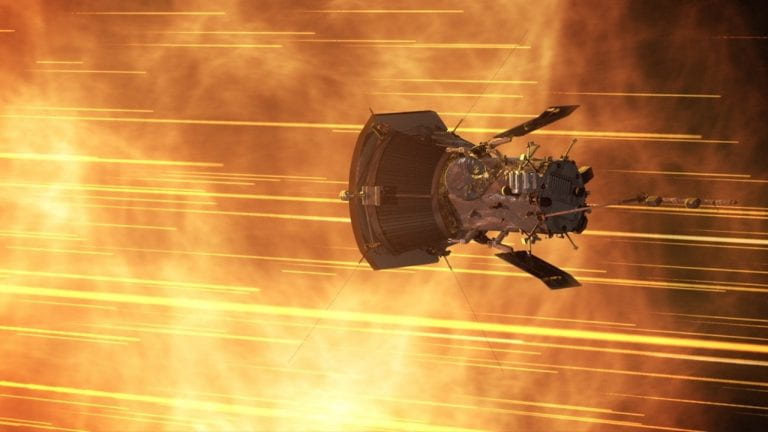NASA’s Parker Solar Probe (PSP) was launched on August 12, 2018, with the goal of becoming the first spacecraft to touch the Sun while teaching us more about our host star than any spacecraft or solar instrument in human history. Now, a recent study submitted to The Astrophysical Journal discusses the incredible data that PSP collected on coronal mass ejections (CMEs) over a four-year period. This study holds the potential to help scientists and the public better understand the CMEs and how they contribute to space weather.
Continue reading “Parker Solar Probe Was Blasted by Coronal Mass Ejections 28 Times in 4 Years”A Monster Solar Storm Struck Earth 14,300 Years Ago
The Sun is such a stable presence in our lives that we often take it for granted. Few things are as certain sure as the rising of the Sun each morning, and the cycles of the seasons mark the years of our lives. But the Sun is a star, and stars can sometimes be unpredictable. They can emit powerful solar flares and powerful X-rays. With our deep dependence on technology and electricity, the Sun poses a small but real risk to our civilization. As a recent study shows, the Sun has had some extremely powerful flares in recent cosmic times.
Continue reading “A Monster Solar Storm Struck Earth 14,300 Years Ago”A Very Powerful Solar Storm Hit the Earth Back in 1582
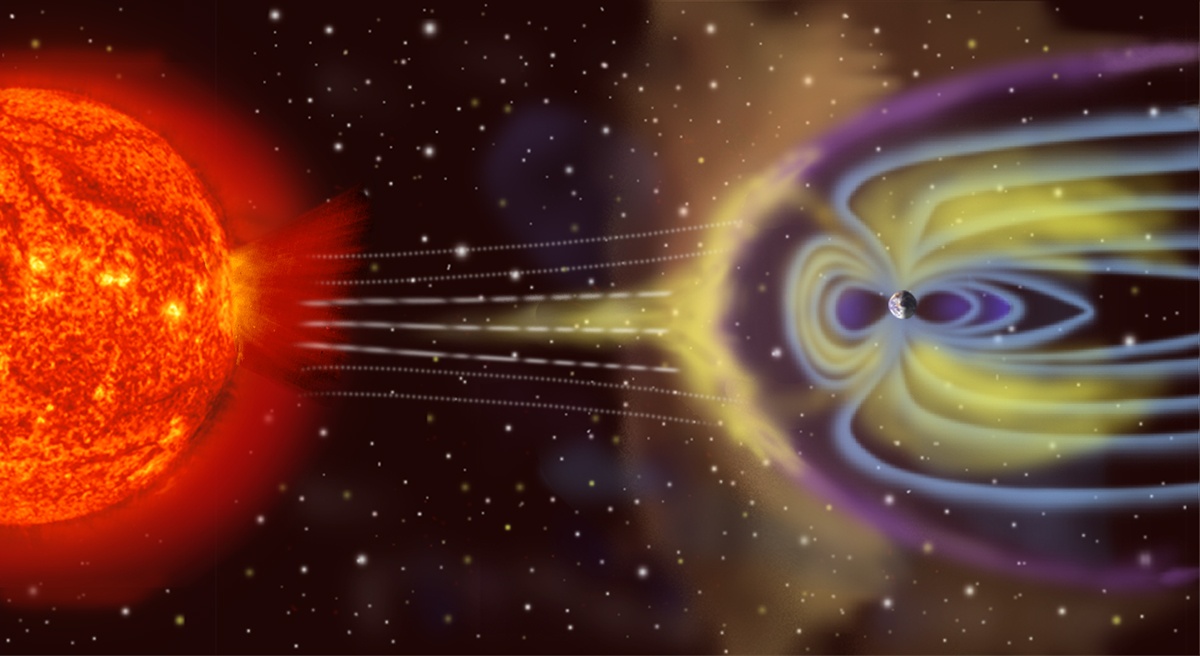
“A great fire appeared in the sky to the North, and lasted three nights,” wrote a Portuguese scribe in early March, 1582. Across the globe in feudal Japan, observers in Kyoto noted the same fiery red display in their skies too. Similar accounts of strange nighttime lights were recorded in Leipzig, Germany; Yecheon, South Korea; and a dozen other cities across Europe and East Asia.
It was a stunning event. While people living at high latitudes were well aware of auroras in 1582, most people living closer to the equator were not. The solar storm that year was unlike anything in living memory, and it was so strong it brought the aurora to latitudes as low as 28 degrees (in line with Florida, Egypt, and southern Japan). People this close to the equator had no frame of reference for such dazzling nighttime displays, and many took it as a religious portent.
Continue reading “A Very Powerful Solar Storm Hit the Earth Back in 1582”Destructive Super Solar Storms Hit Us Every 25 Years Or So
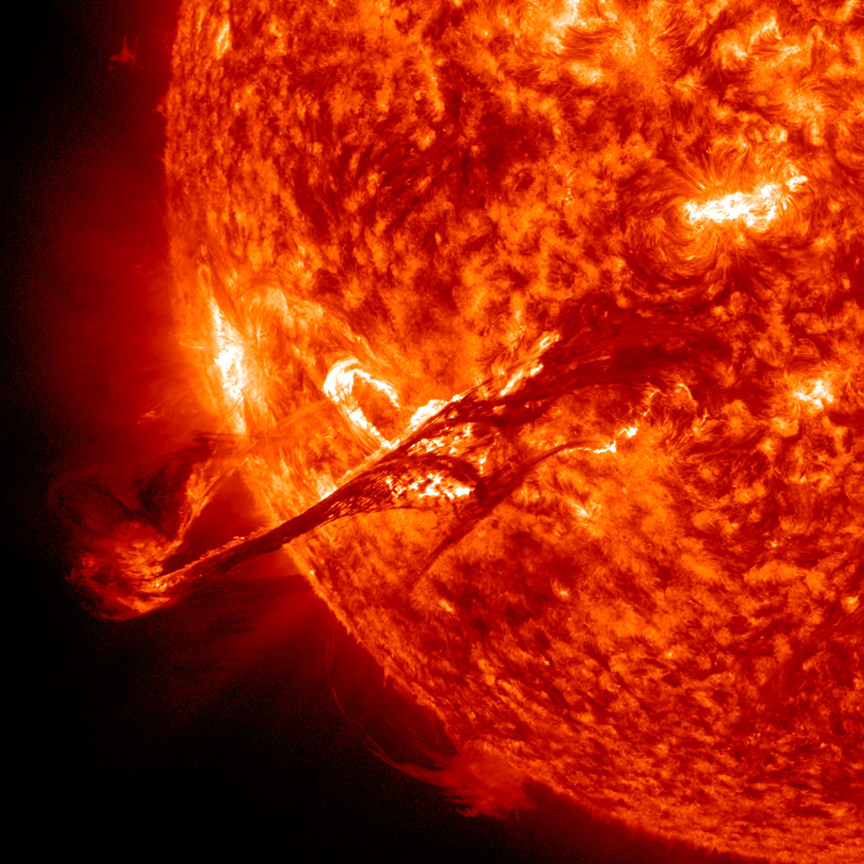
Solar storms powerful enough to wreak havoc on electronic equipment strike Earth every 25 years, according to a new study. And less powerful—yet still dangerous—storms occur every three years or so. This conclusion comes from a team of scientists from the the University of Warwick and the British Antarctic Survey.
These powerful storms can disrupt electronic equipment, including communication equipment, aviation equipment, power grids, and satellites.
Continue reading “Destructive Super Solar Storms Hit Us Every 25 Years Or So”Power Grids and Satellites Are More at Risk from Extreme Solar Storms Than We Thought
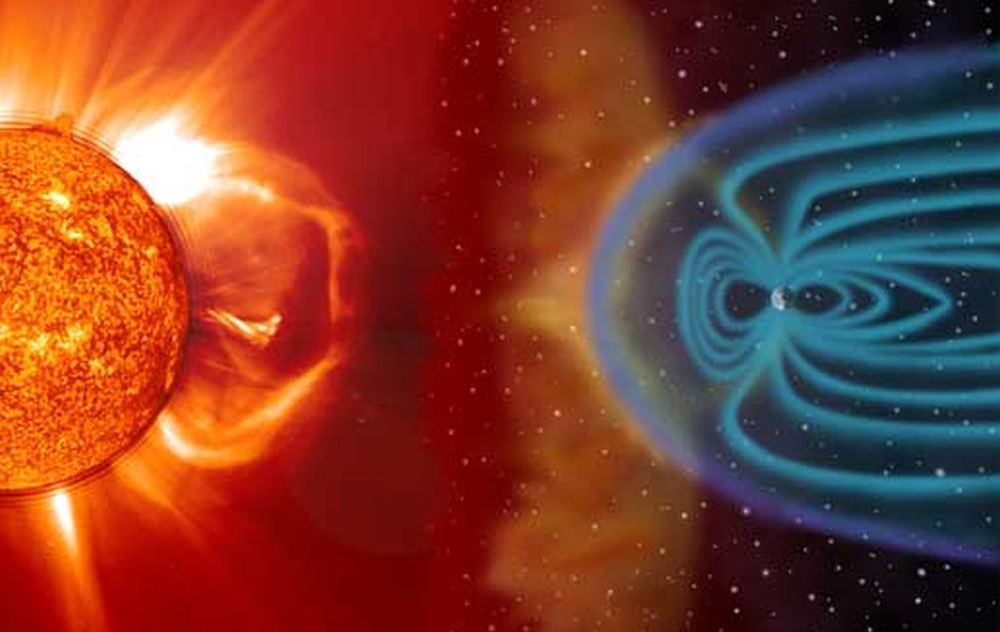
Exactly how dangerous are solar storms? Scientists think the Carrington Event was one of the most powerful ones to ever hit Earth. They also think that storms that powerful only happen every couple centuries or so. But a new study says we can expect more storms equally as strong, and more often.
Continue reading “Power Grids and Satellites Are More at Risk from Extreme Solar Storms Than We Thought”Astronomers Catch a Superflare From a Puny Star
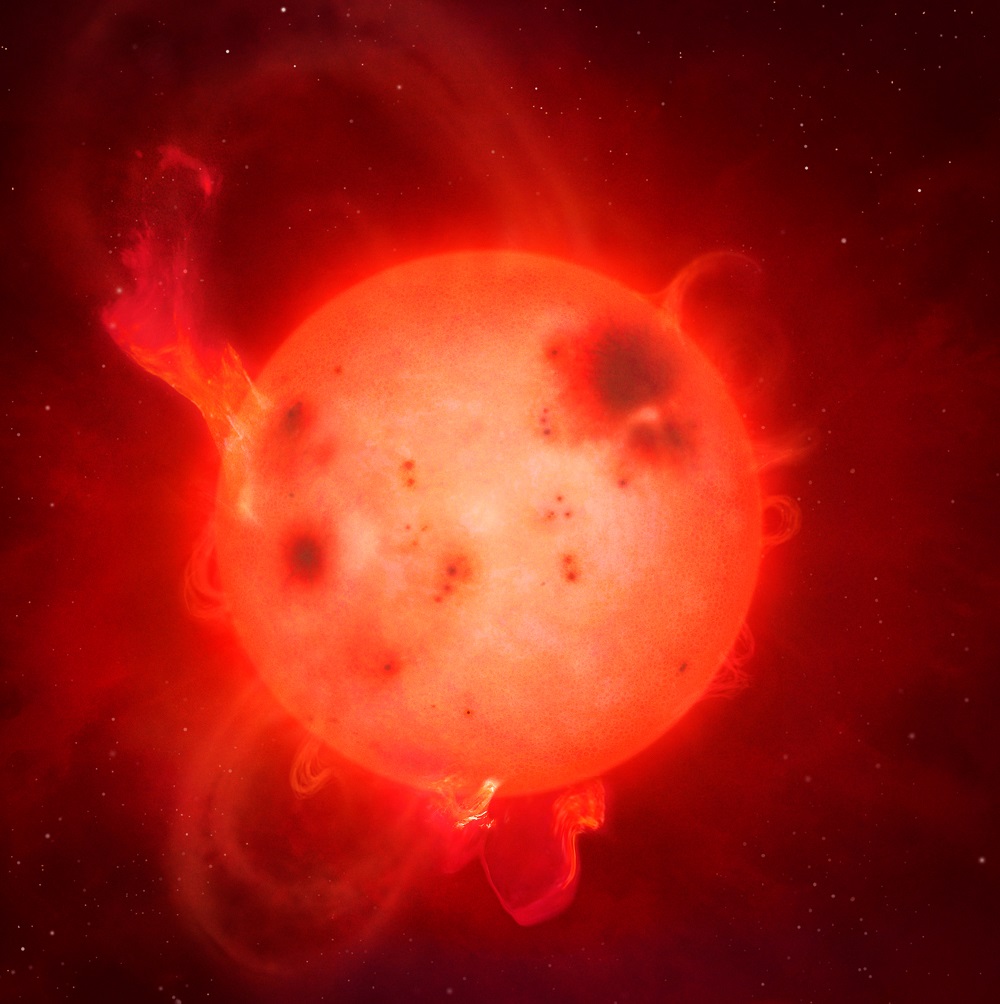
You can be thankful that we orbit a placid, main sequence, yellow dwarf star. Astronomers recently spied a massive superflare on a diminutive star, a powerful, radiation spewing event that you wouldn’t want to witness up close.
Continue reading “Astronomers Catch a Superflare From a Puny Star”New Study Proposes a Giant, Space-Based Solar Flare Shield for Earth
In today’s modern, fast-paced world, human activity is very much reliant on electrical infrastructure. If the power grids go down, our climate control systems will shut off, our computers will die, and all electronic forms of commerce and communication will cease. But in addition to that, human activity in the 21st century is also becoming increasingly dependent upon the infrastructure located in Low Earth Orbit (LEO).
Aside from the many telecommunications satellites that are currently in space, there’s also the International Space Station and a fleet of GPS satellites. It is for this reason that solar flare activity is considered a serious hazard, and mitigation of it a priority. Looking to address that, a team of scientists from Harvard University recently released a study that proposes a bold solution – placing a giant magnetic shield in orbit.
The study – which was the work of Doctor Manasavi Lingam and Professor Abraham Loeb from the Harvard Smithsonian Center for Astrophysicist (CfA) – recently appeared online under the title “Impact and Mitigation Strategy for Future Solar Flares“. As they explain, solar flares pose a particularly grave risk in today’s world, and will become an even greater threat due to humanity’s growing presence in LEO.
Solar flares have been a going concern for over 150 years, ever since the famous Carrington Event of 1859. Since that time, a great deal of effort has been dedicated to the study of solar flares from both a theoretical and observational standpoint. And thanks to the advances that have been made in the past 200 years in terms of astronomy and space exploration, much has been learned about the phenomena known as “space weather”.
At the same time, humanity’s increased reliance on electricity and space-based infrastructure have also made us more vulnerable to extreme space weather events. In fact, if the Carrington event were to take place today, it is estimated that it would cause global damage to electric power grids, satellites communications, and global supply chains.
The cumulative worldwide economic losses, according to a 2009 report by the Space Studies Board (“Severe Space Weather Events–Understanding Societal and Economic Impacts”), would be $10 trillion, and recovery would take several years. And yet, as Professor Loeb explained to Universe Today via email, this threat from space has received far less attention than other possible threats.
“In terms of risk from the sky, most of the attention in the past was dedicated to asteroids,” said Loeb. “They killed the dinosaurs and their physical impact in the past was the same as it will be in the future, unless their orbits are deflected. However, solar flares have little biological impact and their main impact is on technology. But a century ago, there was not much technological infrastructure around, and technology is growing exponentially. Therefore, the damage is highly asymmetric between the past and future.”
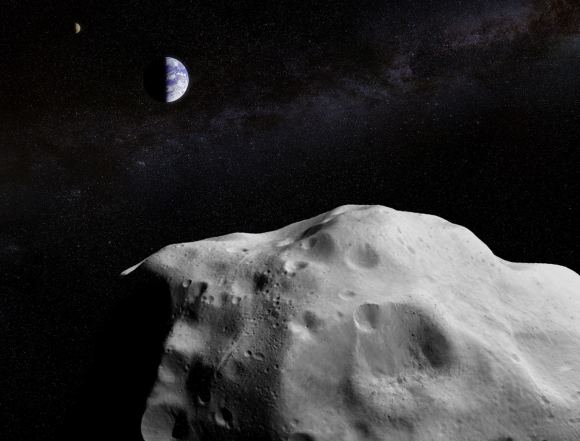
To address this, Lingham and Loeb developed a simple mathematical model to assess the economic losses caused by solar flare activity over time. This model considered the increasing risk of damage to technological infrastructure based on two factors. For one, they considered the fact that the energy of a solar flares increases with time, then coupled this with the exponential growth of technology and GDP.
What they determined was that on longer time scales, the rare types of solar flares that are very powerful become much more likely. Coupled with humanity’s growing presence and dependence on spacecraft and satellites in LEO, this will add up to a dangerous conjunction somewhere down the road. Or as Loeb explained:
“We predict that within ~150 years, there will be an event that causes damage comparable to the current US GDP of ~20 trillion dollars, and the damage will increase exponentially at later times until technological development will saturate. Such a forecast was never attempted before. We also suggest a novel idea for how to reduce the damage from energetic particles by a magnetic shield. This was my idea and was not proposed before.”
To address this growing risk, Lingham and Loeb also considered the possibility of placing a magnetic shield between Earth and the Sun. This shield would be placed at the Earth-Sun Lagrange Point 1, where it would be able to deflect charged particles and create an artificial bowshock around Earth. In this sense, this shield would protect Earth’s in a way that is similar to what its magnetic field already does, but to greater effect.
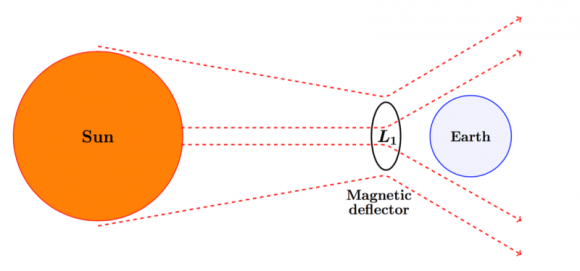
Based on their assessment, Lingham and Loeb indicate that such a shield is technically feasible in terms of its basic physical parameters. They were also able to provide a rudimentary timeline for the construction of this shield, not to mention some rough cost assessments. As Loeb indicated, such a shield could be built before this century is over, and at a fraction of the cost of what would be incurred from solar flare damage.
“The engineering project associated with the magnetic shield that we propose could take a few decades to construct in space,” he said. “The cost for lifting the needed infrastructure to space (weighting 100,000 tons) will likely be of order 100 billions of dollars, much less than the expected damage over a century.”
Interestingly enough, the idea of using a magnetic shield to protect planets has been proposed before. For example, this type of shield was also the subject of a presentation at this year’s “Planetary Science Vision 2050 Workshop“, which was hosted by NASA’s Planetary Science Division (PSD). This shield was recommended as a means of enhancing Mars’ atmosphere and facilitating crewed mission to its surface in the future.
During the course of the presentation, titled “A Future Mars Environment for Science and Exploration“, NASA Director Jim Green discussed how a magnetic shield could protect Mars’ tenuous atmosphere from solar wind. This would allow it to replenish over time, which would have the added benefit of warming Mars up and allowing liquid water to again flow on its surface. If this sounds similar to proposals for terraforming Mars, that’s because it is!
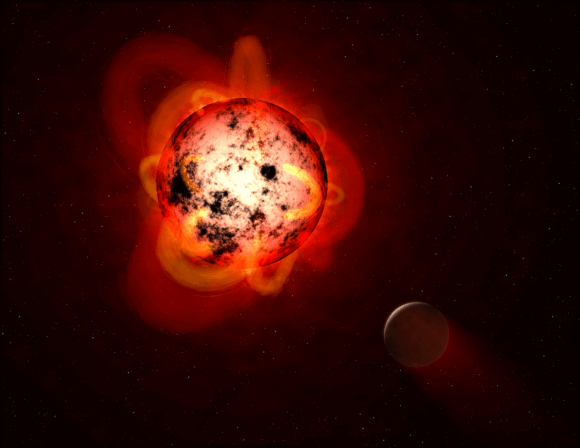
Beyond Earth and the Solar System, the implications for this study are quite overwhelming. In recent years, many terrestrial planets have been found orbiting within nearby M-type (aka. red dwarf) star systems. Because of the way these planets orbit closely to their respective suns, and the variable and unstable nature of M-type stars, scientists have expressed doubts about whether or not these planets could actually be habitable.
In short, scientists have ventured that over the course of billions of years, rocky planets that orbit close to their suns, are tidally-locked with them, and are subject to regular solar flares would lose their atmospheres. In this respect, magnetic shields could be a possible solution to creating extra-solar colonies. Place a large shield in orbit at the L1 Lagrange point, and you never have to worry again about powerful magnetic storms ravaging the planet!
On top of that, this study offers a possible resolution to the Fermi Paradox. When looking for sign of Extra-Terrestrial Intelligence (ETI), it might make sense to monitor distant stars for signs of an orbiting magnetic shield. As Prof. Leob explained, such structures may have already been detected around distant stars, and could explain some of the unusual observations astronomers have made:
“The imprint of a shield built by another civilization could involve the changes it induces in the brightness of the host star due to occultation (similar behavior to Tabby’s star) if the structure is big enough. The situation could be similar to Dyson’s spheres, but instead of harvesting the energy of the star the purpose of the infrastructure is to protect a technological civilization on a planet from the flares of its host star.”
Further Reading: arXiv
Flying Into the Sun? NASA’s Parker Solar Probe Mission
If you’ve read enough of our articles, you know I’ve got an uneasy alliance with the Sun. Sure, it provides the energy we need for all life on Earth. But, it’s a great big ongoing thermonuclear reaction, and it’s right there! As soon as we get fusion, Sun, in like, 30 years or so, I tell you, we’ll be the ones laughing.
But to be honest, we still have so many questions about the Sun. For starters, we don’t fully understand the solar wind blasting out of the Sun. This constant wind of charged particles is constantly blowing out into space, but sometimes it’s stronger, and sometimes it’s weaker.
What are the factors that contribute to the solar wind? And as you know, these charged particles are not healthy for the human body, or for our precious electronics. In fact, the Sun occasionally releases enormous blasts that can damage our satellites and electrical grids.
How can we predict the intensity so that we can be better prepared for dangerous solar storms? Especially the Carrington-class events that might take down huge portions of our modern society.
Perhaps the biggest mystery with the Sun is the temperature of its corona. The surface of the Sun is hot, like 5,500 degrees Celsius. But if you rise up into the atmosphere of the Sun, into its corona, the temperature jumps beyond a million degrees.
The list of mysteries is long. And to start understanding what’s going on, we’ll need to get much much closer to the Sun.
Good news, NASA has a new mission in the works to do just that.
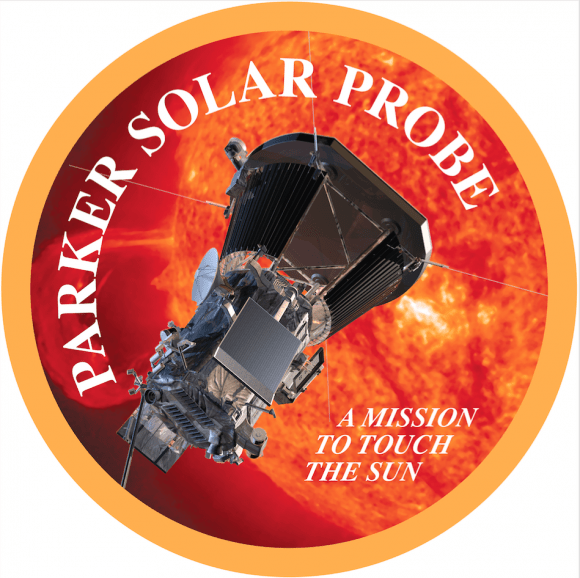
The mission is called the Parker Solar Probe. Actually, last week, it was called the Solar Probe Plus, but then NASA renamed it, and that reminded me to do a video on it.
It’s pretty normal for NASA to rename their spacecraft, usually after a dead astronomer/space scientist, like Kepler, Chandra, etc. This time, though, they renamed it for a legendary solar astronomer Eugene Parker, who developed much of our modern thinking on the Sun’s solar wind. Parker just turned 90 and this is the first time NASA has named it after someone living.
Anyway, back to the spacecraft.
The mission is due to launch in early August 2018 on a Delta IV Heavy, so we’re still more than a year away at this point. When it does, it’ll carry the spacecraft on a very unusual trajectory through the inner Solar System.
The problem is that the Sun is actually a very difficult place to reach. In fact, it’s the hardest place to get to in the entire Solar System.
Remember that the Earth is traveling around the Sun at a velocity of 30 km/s. That’s almost three times the velocity it takes to get into orbit. That’s a lot of velocity.
In order to be able to get anywhere near the Sun, the probe needs to shed velocity. And in order to do this, it’s going to use gravitational slingshots with Venus. We’ve talked about gravitational slingshots in the past, and how you can use them to speed up a spacecraft, but you can actually do the reverse.
The Parker Solar Probe will fall down into Venus’ gravity well, and give orbital velocity to Venus. This will put it on a new trajectory which takes it closer to the Sun. It’ll do a total of 7 flybys in 7 years, each of which will tweak its trajectory and shed some of that orbital momentum.
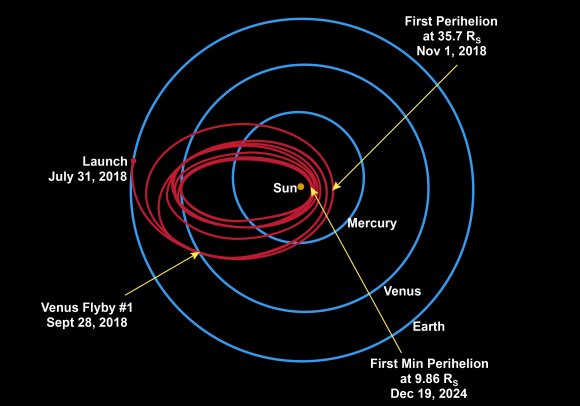
You know, trying to explain orbital maneuvering is tough. I highly recommend that you try out Kerbal Space Program. I’ve learned more about orbital mechanics by playing that game for a few months than I have in almost 2 decades of space journalism. Go ahead, try to get to the Sun, I challenge you.
Anyway, with each Venus flyby, the Parker Solar Probe will get closer and closer to the Sun, well within the orbit of Mercury. Far closer than any spacecraft has ever gotten to the Sun. At its closest point, it’ll only be 5.9 million kilometers from the Sun. Just for comparison, the Earth orbits at an average distance of about 150 million kilometers. That’s close.
And over the course of its entire mission, the spacecraft is expected to make a total of 24 complete orbits of the Sun, analyzing that plasma ball from every angle.
The orbit is also highly elliptical, which means that it’s going really really fast at its closest point. Almost 725,000 km/h.
In order to withstand the intense temperatures of being this close to the Sun, NASA has engineered the Parker Solar Probe to shed heat. It’s equipped with an 11.5 cm-thick shield made of carbon-composite. For that short time it spends really close to the Sun, the spacecraft will keep the shield up, blocking that heat from reaching the rest of its instruments.
And it’s going to get hot. We’re talking about more than 1,300 degrees Celsius, which is about 475 times as much energy as a spacecraft receives here on Earth. In the outer Solar System, the problem is that there just isn’t enough energy to power solar panels. But where Parker is going, there’s just too much energy.
Now we’ve talked about the engineering difficulties of getting a spacecraft this close to the Sun, let’s talk about the science.
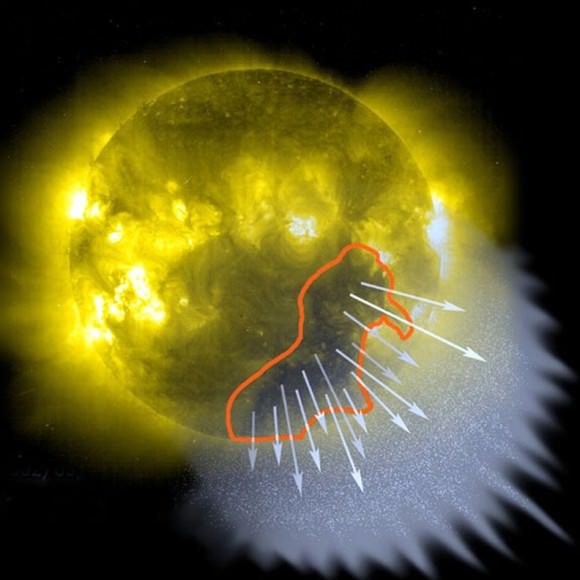
The biggest question astronomers are looking to solve is, how does the corona get so hot. The surface is 5,500 Celsius. As you get farther away from the Sun, you’d expect the temperature to go down. And it certainly does once you get as far as the orbit of the Earth.
But the Sun’s corona, or its outer atmosphere, extends millions of kilometers into space. You can see it during a solar eclipse as this faint glow around the Sun. Instead of dropping, the temperature rises to more than a million degrees.
What could be causing this? There are a couple of ideas. Plasma waves pushed off the Sun could bunch up and release their heat into the corona. You could also get the crisscrossing of magnetic field lines that create mini-flares within the corona, heating it up.
The second great mystery is the solar wind, the stream of charged protons and electrons coming from the Sun. Instead of a constant blowing wind, it can go faster or slower. And when the speed changes, the contents of the wind change too.
There’s the slow wind, that goes a mere 1.1 million km/h and seems to emanate from the Sun’s equatorial regions. And then the fast wind, which seems to be coming out of coronal holes, cooler parts in the Sun’s corona, and can be going at 2.7 million km/h.
Why does the solar wind speed change? Why does its consistency change?
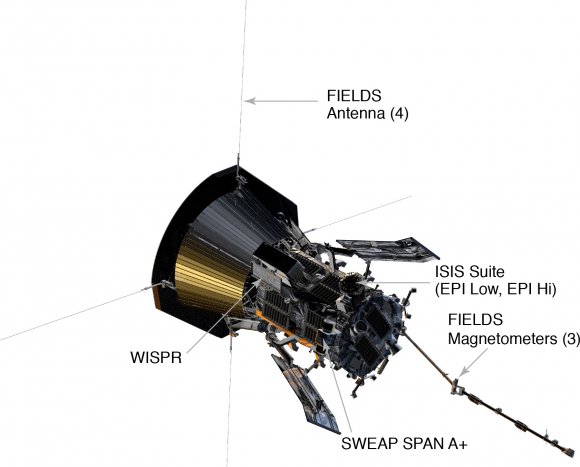
The Parker Solar Probe is equipped with four major instruments, each of which will gather data from the Sun and its environment.
The FIELDS experiment will measure the electric and magnetic fields and waves around the Sun. We know that much of the Sun’s behavior is driven by the complex interaction between charged plasma in the Sun. In fact, many physicists agree that magnetohydrodynamics is easily one of the most complicated fields you can get into.
Integrated Science Investigation of the Sun, or ISOIS (which I suspect needs a renaming) will measure the charged particles streaming off the Sun, during regular solar activity and during dangerous solar storms. Can we get any warning before these events occur, giving astronauts more time to protect themselves?
Wide-field Imager for Solar PRobe or WISPR is its telescope and camera. It’s going to be taking close up, high resolution images of the Sun and its corona that will blow our collective minds… I hope. I mean, if it’s just a bunch of interesting data and no pretty pictures, it’s going to be hard to make cool videos showcasing the results of the mission. You hear me NASA, we want pictures and videos. And science, sure.
And then the Solar Wind Electrons Alphas and Protons Investigation, or SWEAP, will measure type, velocity, temperature and density of particles around the Sun, to help us understand the environment around it.
One interesting side note, the spacecraft will be carrying a tiny chip on board with photos of Eugene Parker and a copy of his original 1958 paper explaining the Sun’s solar wind.
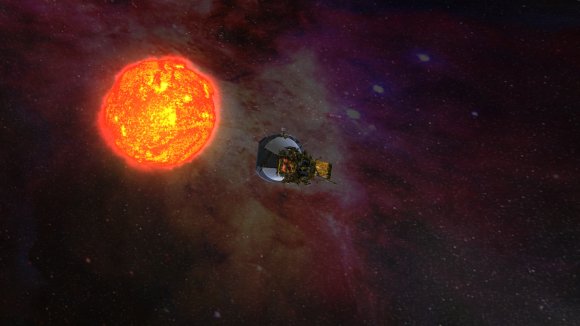
I know we’re still more than a year away from liftoff, and several years away before the science data starts pouring in. But you’ll be hearing more and more about this mission shortly, and I’m pretty excited about what it’s going to accomplish. So stay tuned, and once the science comes in, I’m sure you’ll hear plenty more about it.
What Was the Carrington Event?
Isn’t modern society great? With all this technology surrounding us in all directions. It’s like a cocoon of sweet, fluffy silicon. There are chips in my fitness tracker, my bluetooth headset, mobile phone, car keys and that’s just on my body.
At all times in the Cain household, there dozens of internet devices connected to my wifi router. I’m not sure how we got to the point, but there’s one thing I know for sure, more is better. If I could use two smartphones at the same time, I totally would.
And I’m sure you agree, that without all this technology, life would be a pale shadow of its current glory. Without these devices, we’d have to actually interact with each other. Maybe enjoy the beauty of nature, or something boring like that.
It turns out, that terrible burning orb in the sky, the Sun, is fully willing and capable of bricking our precious technology. It’s done so in the past, and it’s likely to take a swipe at us in the future.
I’m talking about solar storms, of course, tremendous blasts of particles and radiation from the Sun which can interact with the Earth’s magnetosphere and overwhelm anything with a wire.
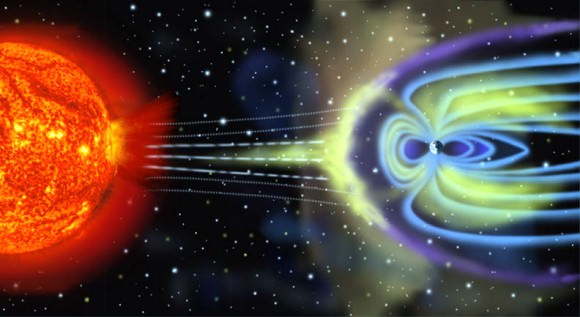
In fact, we got a sneak preview of this back in 1859, when a massive solar storm engulfed the Earth and ruined our old timey technology. It was known as the Carrington Event.
Follow your imagination back to Thursday, September 1st, 1859. This was squarely in the middle of the Victorian age.
And not the awesome, fictional Steampunk Victorian age where spectacled gentleman and ladies of adventure plied the skies in their steam-powered brass dirigibles.
No, it was the regular crappy Victorian age of cholera and child labor. Technology was making huge leaps and bounds, however, and the first telegraph lines and electrical grids were getting laid down.
Imagine a really primitive version of today’s electrical grid and internet.
On that fateful morning, the British astronomer Richard Carrington turned his solar telescope to the Sun, and was amazed at the huge sunspot complex staring back at him. So impressed that he drew this picture of it.
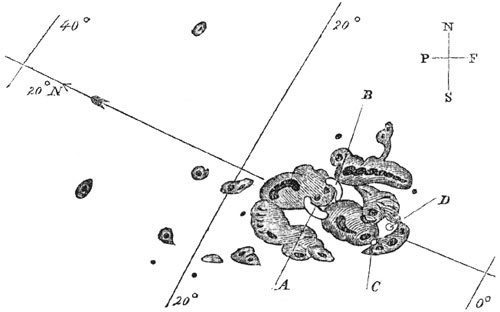
While he was observing the sunspot, Carrington noticed it flash brightly, right in his telescope, becoming a large kidney-shaped bright white flare.
Carrington realized he was seeing unprecedented activity on the surface of the Sun. Within a minute, the activity died down and faded away.
And then about 5 minutes later. Aurora activity erupted across the entire planet. We’re not talking about those rare Northern Lights enjoyed by the Alaskans, Canadians and Northern Europeans in the audience. We’re talking about everyone, everywhere on Earth. Even in the tropics.
In fact, the brilliant auroras were so bright you could read a book to them.
The beautiful night time auroras was just one effect from the monster solar flare. The other impact was that telegraph lines and electrical grids were overwhelmed by the electricity pushed through their wires. Operators got electrical shocks from their telegraph machines, and the telegraph paper lit on fire.
What happened? The most powerful solar flare ever observed is what happened.
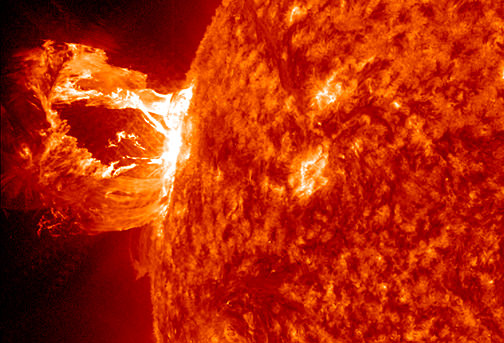
A solar flare occurs because the Sun’s magnetic field lines can get tangled up in the solar atmosphere. In a moment, the magnetic fields reorganize themselves, and a huge wave of particles and radiation is released.
Flares happen in three stages. First, you get the precursor stage, with a blast of soft X-ray radiation. This is followed by the impulsive stage, where protons and electrons are accelerated off the surface of the Sun. And finally, the decay stage, with another burp of X-rays as the flare dies down.
These stages can happen in just a few seconds or drag out over an hour.
Remember those particles hurled off into space? They take several hours or a few days to reach Earth and interact with our planet’s protective magnetosphere, and then we get to see beautiful auroras in the sky.
This geomagnetic storm causes the Earth’s magnetosphere to jiggle around, which drives charges through wires back and forth, burning out circuits, killing satellites, overloading electrical grids.
Back in 1859, this wasn’t a huge deal, when our quaint technology hadn’t progressed beyond the occasional telegraph tower.
Today, our entire civilization depends on wires. There are wires in the hundreds of satellites flying overhead that we depend on for communications and navigation. Our homes and businesses are connected by an enormous electrical grid. Airplanes, cars, smartphones, this camera I’m using.
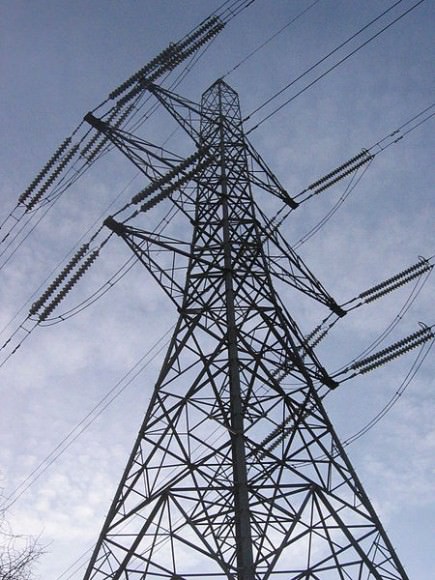
Everything is electronic, or controlled by electronics.
Think it can’t happen? We got a sneak preview back in March, 1989 when a much smaller geomagnetic storm crashed into the Earth. People as far south as Florida and Cuba could see auroras in the sky, while North America’s entire interconnected electrical grid groaned under the strain.
The Canadian province of Quebec’s electrical grid wasn’t able to handle the load and went entirely offline. For 12 hours, in the freezing Quebec winter, almost the entire province was without power. I’m telling you, that place gets cold, so this was really bad timing.
Satellites went offline, including NASA’s TDRS-1 communication satellite, which suffered 250 separate glitches during the storm.
And on July 23, 2012, a Carrington-class solar superstorm blasted off the Sun, and off into space. Fortunately, it missed the Earth, and we were spared the mayhem.
If a solar storm of that magnitude did strike the Earth, the cleanup might cost $2 trillion, according to a study by the National Academy of Sciences.
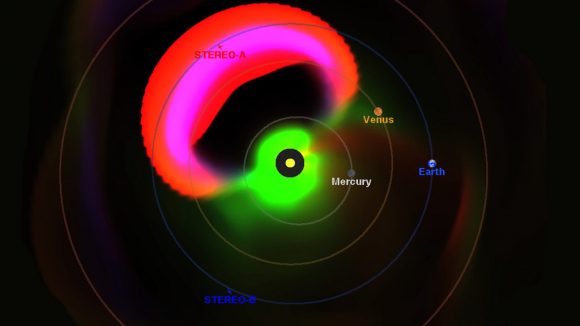
It’s been 160 years since the Carrington Event, and according to ice core samples, this was the most powerful solar flare over the last 500 years or so. Solar astronomers estimate solar storms like this happen twice a millennium, which means we’re not likely to experience another one in our lifetimes.
But if we do, it’ll cause worldwide destruction of technology and anyone reliant on it. You might want to have a contingency plan with some topic starters when you can’t access the internet for a few days. Locate nearby interesting nature spots to explore and enjoy while you wait for our technological civilization to be rebuilt.
Have you ever seen an aurora in your lifetime? Give me the details of your experience in the comments.
The White House Releases a Report on Space Weather
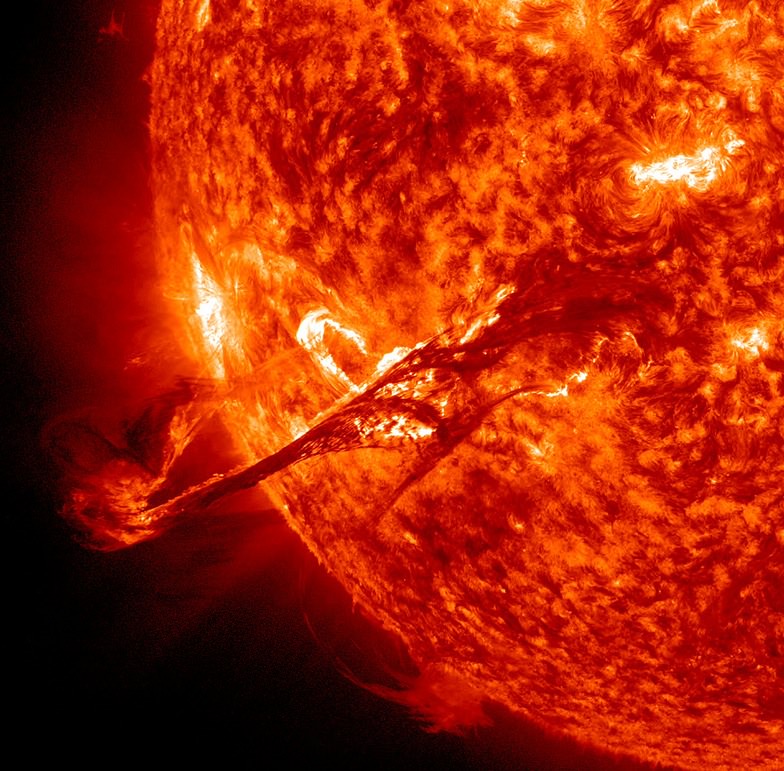
We live on a planet dominated by weather. But not just the kind that comes in the form of wind, rain, and snow — we are also under the influence of space weather, generated by the incredible power of our home star a “mere” 93 million miles away. As we orbit the Sun our planet is, in effect, inside its outer atmosphere, and as such is subject to the constantly-flowing wind of charged particles and occasional outbursts of radiation and material that it releases. Although it may sound like something from science fiction, space weather is very real… and the more we rely on sensitive electronics and satellites in orbit, the more we’ll need to have accurate weather reports.
Fortunately, the reality of space weather has not gone unnoticed by the U.S. Federal Government.
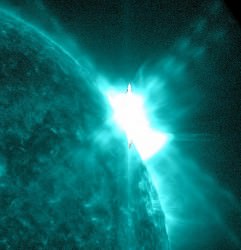
Today the White House Office of Science and Technology Policy released a new report, Space Weather Observing Systems: Current Capabilities and Requirements for the Next Decade, which is an assessment of the United States government’s capacity to monitor and forecast potentially harmful space weather and how to possibly mitigate the damage from any exceptionally powerful solar storms in the future.
The report was made by a Joint Action Group (JAG) formed by the National Space Weather Program Council (NSWPC).
The impacts of space weather can have serious economic consequences. For example, geomagnetic storms during the 1990’s knocked out several telecommunications satellites, which had to be replaced at a cost of about $200 million each. If another “once in a century” severe geomagnetic storm occurs (such as the 1859 “super storm”), the cost on the satellite industry alone could be approximately $50 – $100 billion. The potential consequences on the Nation’s power grid are even higher, with potential costs of $1 – 2 trillion that could take up to a decade to completely repair.
– Report on Space Weather Observing Systems: Current Capabilities and Requirements for the Next Decade (April 2013)
“In other words,” according to the report, “the Nation is at risk of losing critical capabilities that have significant economic and security impacts should these key space weather observing systems fail to be maintained and replaced.”
Obviously, not good.
Read the full report here, and follow current and ongoing space weather events on the NOAA’s Space Weather Prediction Center website.
Source: White House Office of Science and Technology Policy
The National Space Weather Program is a Federal interagency initiative with the mission of advancing the improvement of space weather services and supporting research in order to prepare the country for the technological, economic, security, and health impacts that may arise from extreme space weather events.

